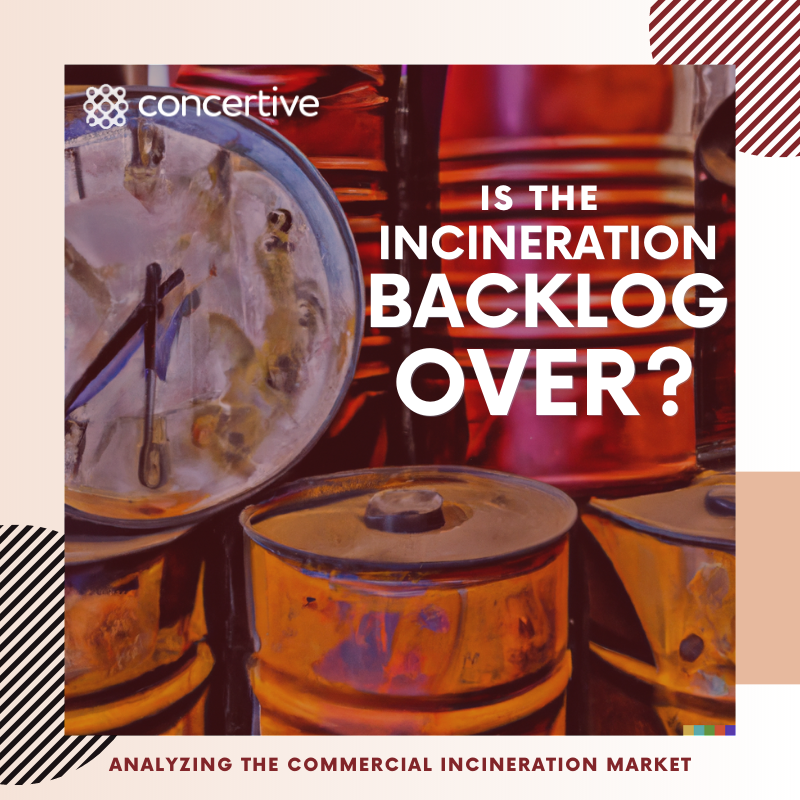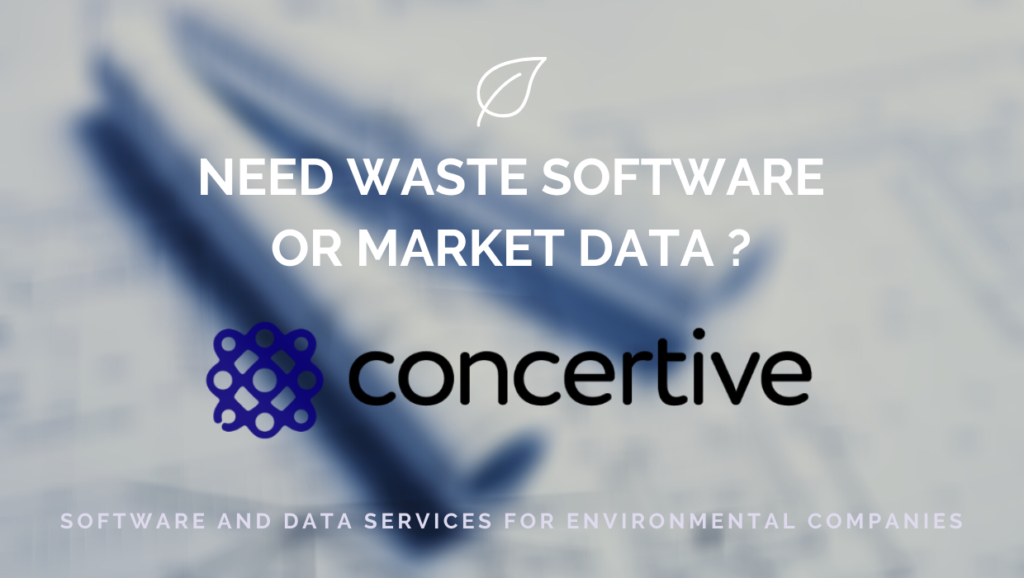
“At capacity” is a fairly common phrase to hear these days when trying to schedule a truck of waste into a RCRA-permitted incinerator. The capacity issue became so bad that in 2021 EPA had to step in with a memo entitled “Regulatory Options for Addressing the Temporary Backlog of Containerized Hazardous Waste Needing Incineration.” What caused this incineration capacity issue and is it improving?
Incineration capacity was already tight prior to Covid. Then add in Covid lockdowns and worker shortages, demand for incineration then surpassed the available supply. However, instead of bouncing back during Covid recovery, incineration capacity decreased further with a captive incinerator closing and then in 2022 another commercial incinerator drastically reduced capacity due to an incident during maintenance.
Is the incineration backlog over? No it’s not over. Capacity is improving in 2023 but it’s not enough to work through the volumes that have been sidelined. It’s likely we won’t see broad improvement in the market until 2024. That’s also when incinerator expansions from both Clean Harbors and Veolia are slated to be complete.
Read below for a more in-depth look at incineration volumes, the factors contributing to the incineration backlog and a look ahead.
*Please note this article is focused on the primary commercial incinerators. Specialized commercial incinerators like General Dynamics (EBV Explosives) and Eco Services and also captive incinerators like Dow and PPG will not be focused on in this article.
Table of Contents
Incineration Volumes
Management Method
Incineration is the 5th largest management method for treating federally hazardous waste.
Of the nearly 9.4 million tons of waste recorded in e-Manifest for 2022, 6.5% went for incineration. The numbers below include both EPA Hazardous and Non-Hazardous wastes.
However, nearly 15% of all waste shippers utilized an incinerator for at least one of their waste streams in 2022.
Annual Volumes
Annual incineration volumes reported in e-Manifest are not flat but have trended down. It makes sense for 2020 and 2021 to have trended downward with Covid restrictions and worker shortages…and then we go slightly down again 2022 which we will explain further below.
Volumes below are for all wastes incinerated (H040) not just volumes to the primary commercial incinerators.
Map of Facilities Shipping To Incinerators
Here is a map of all facilities in e-Manifest (we call them Shippers in Knowsys) that sent waste material for incineration. In 2022, nearly 34,000 facilities were vying for inslots and space. Tens of thousands of facilities that all need to ship into a dozen or so commercial incinerators. The backlog is starting to make more sense.
Incineration Market Share
Below is a map showing the primary commercial incinerators. Size and color of the circle reflects the tonnage received.
The below chart shows the commercial incineration market share amongst the primary 4 incineration companies. Clean Harbors facilities are accepting ~60% of all incinerated material in 2022, Veolia comes in next at ~19% of the US’s hazardous waste, Ross is receiving ~14% and Heritage ~7%.
The below chart shows volumes by individual incinerator grouped under their parent company.
The final chart shows historical incineration volumes by parent company. This chart may best illustrate why the backlog started and has persisted. The periodic reductions in capacity in 2020, 2021 and 2022 and not seeing 140,000+ quarterly tons received consistently amongst these companies illustrate why backlog has continued in the market.
Why Is There Backlog In The Incineration Market?
Volume surges in the chemical industry, reduced incineration capacity due to lockdowns, worker shortages and the closing of a captive incinerator. We will take a deeper look at the causes of the incineration backlog.
Top 10 Incinerators Quarterly Volumes
Below we show quarterly volumes for the top 10 incinerators (based on tons received.) Pay special attention to 3M’s volume and Heritage Thermal Services. (Tip: hover your mouse of the legend of the chart to see the corresponding line)
You can see above that 3M’s volumes decline and then stop abruptly in Q4 2021 and Heritage has a steep decline in Q3 and Q4 of 2022. Fortunately some of the other incinerators were able to ramp up their volumes received for incineration.
3M Cottage Grove
Volumes Incinerated from Offsite and Generated
In the prior chart we see that in 2022 no volumes were received into 3M’s Cottage Grove facility. This facility was receiving 25,000 tons annually from other external 3M sites.
In addition to the volumes received from offsite, according to Biennial Report data (BRS), Cottage Grove was generating and incinerating onsite around 3 million pounds of its own waste (1500 tons) per year. See chart below based on BRS data.
Where Is This Volume Going To Go?
Where will 3M’s volumes go now that they are no longer incinerating internally? An article from Pioneer Press quotes 3M stating, they will “leverage Clean Harbors’ expertise in this area so we can focus on competencies that are core to our business”. Read article here
3M Incineration Volumes, 2022
The below table shows all volumes shipped for incineration from 3M in 2022. Nearly 35,000 tons shipped for incineration in 2022.
Heritage East Liverpool
Maintenance Incident In 2022
Heritage Thermal Services in East Liverpool, OH (formerly WTI) was receiving around 30 million pounds a quarter until Q3 2022. A maintenance incident in June 2022 caused the facility to drastically reduce volumes received. This resulted in the facility receiving 2-4 million pounds in Q3 and Q4 compared to 30 million in previous quarters. A reduction of an estimated 54 million pounds (27,000 tons) of incineration capacity for these 2 quarters.
Are Volumes Back To Normal?
You can see in January 2023 volumes started climbing back up and look to be back in full swing by February 2023.
Cement Kilns
Another point to mention is the cement kilns, that burn hazardous wastes as fuel and can offset some of the tonnage going into incinerators. However these facilities have experienced quite a backlog of material since the winter storms in 2021 coincided with several facilities already down for scheduled turnarounds.
A Look Ahead
Existing Backlog
Incinerators were already backlogged prior to 3M’s decision and the incident at Heritage East Liverpool. These 2 factors alone may have created an additional 55-65,000 tons of incinerables sitting on the sidelines.
Increased Incineration Capacity In 2023
If we look again at our total incineration numbers below. We were at a good pace in Q1 & Q2 2022. With Heritage back at their normal capacity and if all the other players remain consistent, we could have an additional 20-30,000 tons of capacity in 2023 compared to 2022 amongst the primary commercial incinerators.
Backlog At Transfer Facilities Improving
The below chart shows the average amount of days from shipment date to date received by the incinerator. At one point in 2022 the average duration from shipment to receipt was up 10 days to nearly 26 days. We now see a downward trend starting in the latter half of 2022 showing that backlog at 10 day transfer facilities is improving and total transit times are coming down.
*Please note we have updated the below chart. The prior chart was based on averaging the number of days from shipment of a manifest to receipt at an incinerator and separating into incinerable and non-incinerable line items (dates were averaged by line item…incineration/management method is determined at the line item level.) The below chart is based on the average of the manifest (not the line item) and we flag the manifest as containing an incinerable line item. This change added approximately 3 days to length of time for a manifest to be received for incineration.
Veolia Gum Springs, AR
Veolia broke ground on a $600 million expansion at their Gum Springs, AR facility. Veolia has very high expectations for the expansion stating it will “transform the hazardous waste industry so that people will think of it as ‘Before Gum Springs’ and ‘After Gum Springs'” (Veolia Press Release).
The press release states “the plant will also safely treat over 100,000 tons of waste materials per year”. If the existing incineration capacity is backed out of the new capacity (the existing operations will be replaced), this will add around another 80,000 tons of incineration capacity.
Clean Harbors Kimball, NE
With a slated completion date of June 2024, Clean Harbors is expanding it’s incinerator in Kimball, NE. Volumes will increase from 50,000 tons per year to 120,000 tons. (Star Herald Article). So, possibly by mid-2024 we will have an additional 70,000 annual tons of capacity.
More Captives To Exit Incineration
With the safety risks and the myriad of environmental permits and regulations to navigate, we feel it is very likely that more captive (non-commercial) incinerators will cease incinerating their own waste and subcontract like 3M. The downside risk of accidents and non-compliance continue to grow as higher emphasis is placed on ESG scores and protecting a corporation’s brand.
Conclusion
In summary, we are likely looking at 50-65,000 tons of backlog compared to a hopeful increase of 20-30,000 tons in incineration volumes received in 2023. It seems likely that difficulties getting incineration inslots will remain a challenge at least until 2024.
Resources
Veolia Blog Post “Why Is The Incineration Market Backlogged?”
Stay Tuned
We will have more analysis concerning US waste volumes, e-Manifest and other waste trends. Please sign up to keep up with the latest in hazardous waste trends.
How We Get Our Data
All data and analytics comes from our Knowsys application. Knowsys brings together numerous environmental, compliance and industry datasets. We believe Knowsys to be the most comprehensive, current and connected business intelligence application for solid and hazardous waste.
See for yourself, if you would like us to demo the Knowsys application or learn other ways we can help your company, please contact us.

